
CASSIAR GOLD INTERSECTS 50.2 M OF 0.66 G/T AU, INCLUDING 15.6 M OF 1.22 G/T GOLD MINERALIZATION AT CASSIAR SOUTH

Cassiar Gold Corp. (TSX-V: GLDC) (OTCQX: CGLCF) is pleased to announce assay results from the remaining 13 previously unreported drill holes from the Cassiar South project area as part of the 2022 exploration program completed at the Company’s flagship Cassiar Gold Property. The results reported here are part of continuing efforts to further explore for extensions of, and for new parallel veins associated with the high-grade, historically producing mines at Cassiar South.
Cassiar Gold’s 2022 exploration program comprised 23,000 meters in 70 diamond drill holes focused on strategic areas of the Taurus Deposit, as well as significant vein prospects in Cassiar South and other brownfields targets. These 13 drill holes totaling 5,259 metres reported here represent the final results from the Company’s 2022 drill program.
Highlights from the Cassiar South project area:
- Drill hole 22MM-001 intersected 15.9 m of 0.98 g/t Au, including 5.9 m of 1.50 g/t Au, 120 m west of historical workings and 260 m northwest of previously mined vein segments at the Main Mine area (Figure 1).
- Drill hole 22MM-003 intersected multiple mineralized intercepts which support the interpreted orientation of mineralized veins encountered in 22MM-001, returning:
- 50.2 m of 0.66 g/t Au from 126.9 m downhole, including 8.6 m of 0.95 g/t Au and 10.3 m of 0.92 g/t Au,
- 15.6 m of 1.22 g/t Au from 197.0 m downhole,
- 9.0 m of 1.01 g/t Au from 219.8 m downhole
- Multiple intercepts above 4.00 g/t Au were returned from additional vein targets, including:
- 0.6 m of 4.18 g/t Au from 255.5 m in drill hole 22MM-002 at the Main Mine area
- 2.0 m of 4.80 g/t Au from 28.0 m in drill hole 22VOL-701 and 1.2 m of 5.77 g/t Au from 28.7 m in drill hole 22VOL-701A at the Vollaug target area
- 7.20 g/t Au over 0.8 m from 21.5 m in drill hole 22CU-407 at the Cusac area.
- All holes drilled intersected gold-bearing quartz veins containing anomalous to high-grade gold across target areas reported in this news release.
- Mineralization encountered at the Main Mine area occurs within an unmined area with extensive alteration and vein density suggesting proximity to major shear veins.
“Our drill program at Cassiar South encountered gold mineralization in all drill holes, achieving our program objectives and supporting our exploration model,” stated Marco Roque, CEO of Cassiar Gold Corp. “We are eager to build upon the successes of our exploration efforts to-date during the 2023 exploration campaign, which is anticipated to start in early June.”
Table 1. Significant 2022 drilling results from Cassiar South based on a >0.5 g/t cutoff. While true thickness has not been established, drill holes are designed to cross at high to moderate angles within known corridors of mineralization based on orientations of mineralized areas defined by previous drilling and structural data from oriented drill core and outcropping veins.
| Target Area | Drillhole | From | To | Length* | Grade | |
| Main Mine | 22MM-001 | 115.9 | 131.8 | 15.9 m | 0.98 g/t Au | |
| incl. | 120.6 | 126.4 | 5.9 m | 1.50 g/t Au | ||
| 22MM-002 | 180.1 | 181.1 | 0.9 m | 1.60 g/t Au | ||
| 234.7 | 236.9 | 2.2 m | 0.94 g/t Au | |||
| 255.5 | 256.1 | 0.6 m | 4.18 g/t Au | |||
| 269.0 | 294.1 | 25.2 m | 0.59 g/t Au | |||
| incl. | 271.2 | 272.1 | 0.9 m | 2.36 g/t Au | ||
| with | 271.7 | 272.1 | 0.4 m | 4.58 g/t Au | ||
| and | 279.5 | 282.0 | 2.4 m | 1.10 g/t Au | ||
| and | 287.4 | 290.3 | 2.9 m | 1.13 g/t Au | ||
| with | 287.4 | 287.9 | 0.5 m | 3.34 g/t Au | ||
| 308.6 | 332.8 | 24.2 m | 0.61 g/t Au | |||
| incl. | 308.6 | 309.0 | 0.4 m | 4.58 g/t Au | ||
| and | 317.3 | 319.8 | 2.4 m | 1.09 g/t Au | ||
| and | 324.4 | 327.4 | 3.0 m | 1.26 g/t Au | ||
| with | 324.4 | 325.1 | 0.6 m | 3.34 g/t Au | ||
| 488.8 | 490.8 | 1.9 m | 0.88 g/t Au | |||
| 22MM-003 | 126.9 | 177.2 | 50.2 m | 0.66 g/t Au | ||
| incl. | 126.9 | 127.8 | 0.8 m | 1.33 g/t Au | ||
| and | 142.7 | 143.5 | 0.8 m | 2.19 g/t Au | ||
| with | 142.7 | 143.0 | 0.3 m | 3.41 g/t Au | ||
| and | 152.0 | 160.6 | 8.6 m | 0.95 g/t Au | ||
| and | 166.9 | 177.2 | 10.3 m | 0.92 g/t Au | ||
| 197.0 | 212.6 | 15.6 m | 1.22 g/t Au | |||
| 219.8 | 228.9 | 9.0 m | 1.01 g/t Au | |||
| Vollaug | 22VOL-701 | 28.0 | 30.0 | 2.0 m | 4.80 g/t Au | |
| incl. | 29.0 | 30.0 | 1.0 m | 7.03 g/t Au | ||
| 22VOL-701A | 28.7 | 29.9 | 1.2 m | 5.77 g/t Au | ||
| 22VOL-702 | 338.6 | 339.3 | 0.7 m | 1.49 g/t Au | ||
| Cusac | 22CU-403 | 55.5 | 56.6 | 1.1 m | 1.07 g/t Au | |
| 120.9 | 122.0 | 1.1 m | 1.07 g/t Au | |||
| 236.2 | 236.8 | 0.6 m | 1.34 g/t Au | |||
| 251.3 | 252.1 | 0.8 m | 1.30 g/t Au | |||
| 277.5 | 278.5 | 0.9 m | 1.53 g/t Au | |||
| 384.4 | 384.9 | 0.5 m | 2.25 g/t Au | |||
| 22CU-404 | 184.7 | 186.3 | 1.7 m | 1.46 g/t Au | ||
| 22CU-405 | 328.0 | 328.7 | 0.7 m | 0.99 g/t Au | ||
| 22CU-406 | 78.9 | 80.0 | 1.2 m | 1.25 g/t Au | ||
| 88.8 | 89.8 | 1.1 m | 1.52 g/t Au | |||
| 208.9 | 209.8 | 0.9 m | 1.02 g/t Au | |||
| 22CU-407 | 21.1 | 24.5 | 3.4 m | 2.35 g/t Au | ||
| incl. | 21.5 | 22.3 | 0.8 m | 7.20 g/t Au | ||
| 123.0 | 124.6 | 1.6 m | 0.94 g/t Au | |||
| 135.8 | 137.9 | 2.1 m | 1.25 g/t Au | |||
| 22BCB-601 | abandoned | |||||
| Pooley Pass | 22POP-800 | 304.9 | 305.4 | 0.5 m | 2.16 g/t Au | |
| *Drill core lengths are reported here. True widths for these intervals have not been established | ||||||
2022 Cassiar South Project Area
The Cassiar South project area of the Cassiar Gold Property hosts numerous shear vein targets and several past-producing underground mines including the Bain, Cusac, Vollaug and Main Mines, which have historically produced over 315,000 ounces of gold grading between 10 to 20 g/t Au[1]. The past producing high-grade Vollaug vein is known to have a strike length of up to 3 km.
Veins at Cassiar South are classic, orogenic-style, high-grade gold veins with free gold. They occur in mafic volcanic rocks stacked between low-angle listwanite-bearing thrust surfaces and lenses of fine-grained clastic sediments. Vein sets occur in multiple mafic volcanic units, and there is potential to define: (1) stacked veins below known veins in mafic volcanic units of underlying thrust panels; parallel vein sets beneath overlying sedimentary and listwanite units within thrust panels; (3) extensions of known vein systems.

Figure 1. Cassiar South 2022 drill campaign location plan map, with the location of drill holes reported within this release contained within the blue squares (shown in detail in Figures 5 and 7).
Drill holes reported in this news release are shown with yellow collars while 2022 drill holes for which assays have been previously reported are in orange. Dashed purple lines illustrate potential for periodicity of parallel vein systems in untested areas between historical drilling and blind veins beneath sedimentary cover. Notes – Historical production figures from Zelligan, Moors, Jolette, April 28, 2022. National Instrument 43-101 Technical Report on the Cassiar Gold Property, prepared for Cassiar Gold Corp, and references therein.
Main Mine Target
The Main Mine vein system historically produced 150,000 ounces of gold at an average grade of 17.14 g/t Au intermittently from 1979 to 2007[2]. In 2022, the Company drilled three holes at the Main Mine area to evaluate the potential for: (1) parallel shear vein sets to occur near the historical mine, and (2) down dip extensions of past-producing vein segments.
Drill Holes 22MM-001 and 22MM-003
Drill holes 22MM-001 and 22MM-003 (Table 1; Figure 1, 2, 5) were designed to test potential parallel vein sets north and west of the historical Main Mine infrastructure in an area where shear veins have not previously been identified. These drill holes encountered broad intercepts of anomalous gold mineralization associated with extensive strong quartz-carbonate-sericite alteration and high quartz vein density (Figure 3) which may indicate close proximity to a major shear vein structure in areas distal to known veins. Similar broad zones of vein development occur proximal to, or along strike from, historically mined veins, which suggests that these form highly prospective areas for the potential discovery of new veins.
Drill hole 22MM-001 returned 15.9 m of 0.98 g/t Au from 115.9 m downhole, including 5.9 m of 1.50 g/t Au, 120 m west of historical workings and 260 m northwest of previously mined vein segments (Figure 2).
Drill hole 22MM-003 identified the continuation of veining 40-60 m west of 22MM-001. This hole supports the interpreted orientation of mineralized veining intersected in 22MM-001, encountered visible gold in quartz veining (Figure 4), and returned several broad low-grade intercepts, including:
- 50.2 m of 0.66 g/t Au from 126.9 m downhole, including 0.8 m of 1.33 g/t Au, and 0.8 m of 2.19 g/t Au with 0.3 m of 3.41 g/t Au
- 15.6 m of 1.22 g/t Au from 197.0 m downhole
- 9.0 m of 1.01 g/t Au from 219.8 m downhole
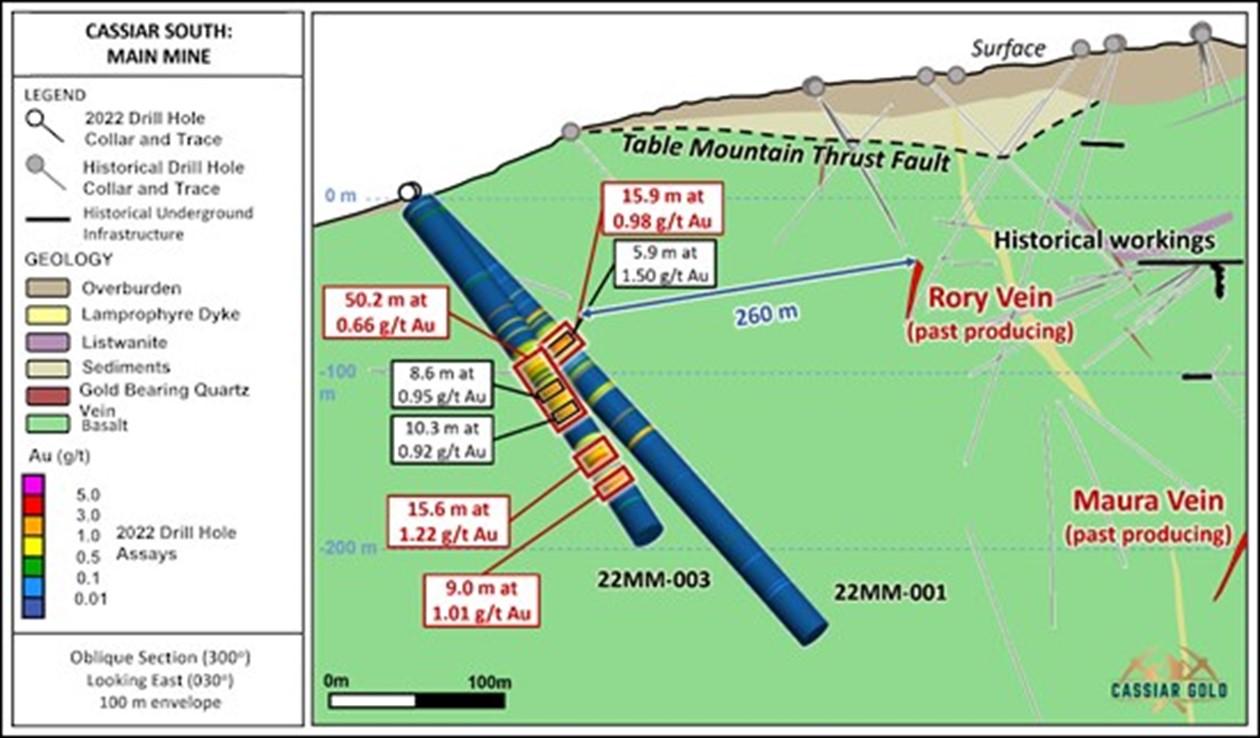
Figure 2. Oblique vertical section showing 22MM-001 and 22MM-003 at the Main Mine target area, looking to the east.
Assay results in red and higher grade nested intervals in black are reported in this news release. Section width +/- 50m.
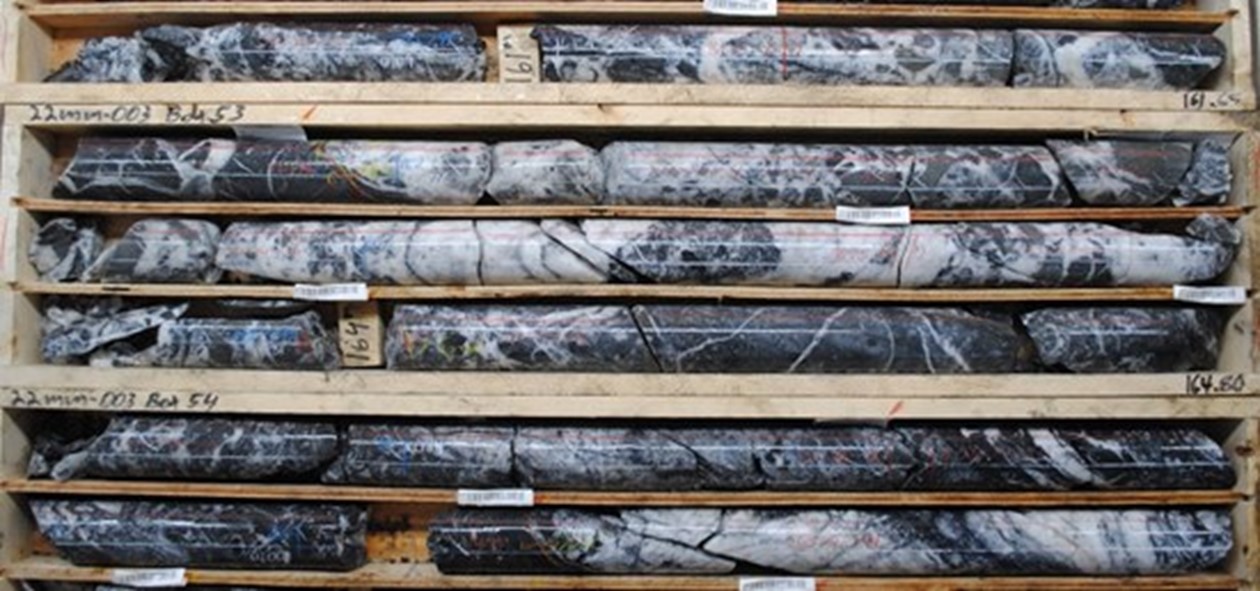
Figure 3. 22MM-003 drill core photo depicting high density veining encountered within a 50.2 m intercept of 0.66 g/t Au (drill core length).
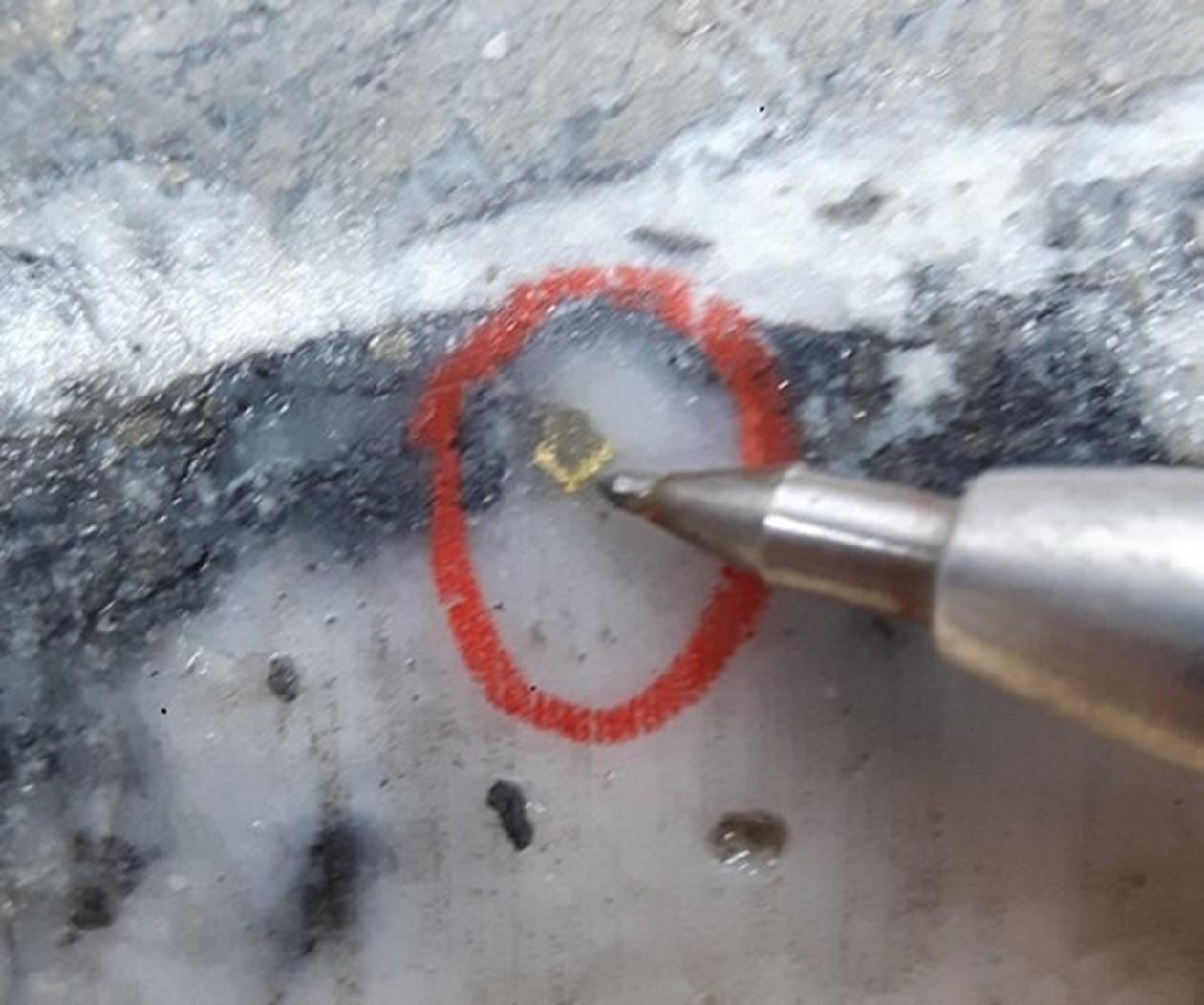
Figure 4. Visible gold encountered in 22MM-003 hosted in a sulphide-mineralized quartz vein at 142.9 m depth with a 1 mm wide partial rim of visible gold around a grain of pyrite within a quartz vein.
Drill Hole 22MM-002
Drill hole 22MM-002 was designed to evaluate the potential down dip extensions of past producing vein segments 50 m below the 1180 m level of the Main Mine underground infrastructure. This drill hole encountered broad intercepts of anomalous gold mineralization associated with intense quartz-carbonate-sericite alteration and extensive high density quartz veins. This hole identified the interpreted down dip extensions of past producing vein segments of the Main Mine.
Results from 22MM-002 returned (Table 1, Figure 5):
- 25.2 m of 0.59 g/t Au from 269.0 m downhole, including
- 0.9 m of 2.36 g/t Au with 0.4 m of 4.58 g/t Au, and
- 2.4 m of 1.10 g/t Au, and
- 2.9 m of 1.13 g/t Au with 0.5 m of 3.34 g/t Au
- 24.2 m of 0.61 g/t Au from 308.6 m downhole, including
- 0.4 m of 4.58 g/t Au, and
- 2.4 m of 1.09 g/t Au, and
- 3.0 m of 1.26 g/t Au with 0.6 m of 3.34 g/t Au
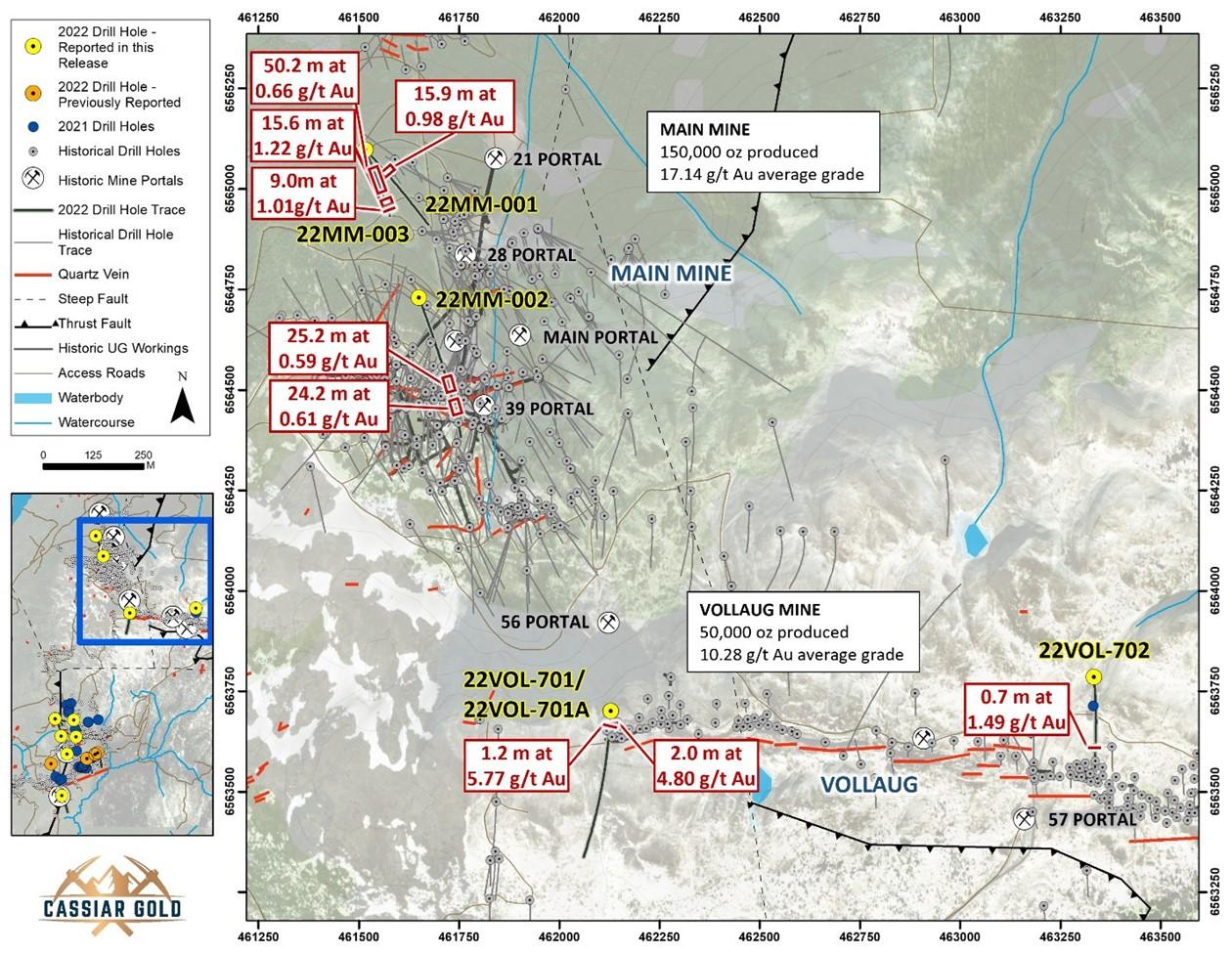
Figure 5. Plan map of 2022 drill holes reported in this news release, the location of which is shown in Figure 1. The vertical projection of the mineralized intercepts which are reported here are included for reference.
Notes – Historical production figures from Zelligan, Moors, Jolette, April 28, 2022. National Instrument 43-101 Technical Report on the Cassiar Gold Property, prepared for Cassiar Gold Corp, and references therein.
Vollaug Vein Target
The Vollaug vein system historically produced 50,000 ounces of gold at an average grade of 10.28 g/t Au from 1980 to 1997[3]. The vein is up to 3 m wide and occupies a nearly three-kilometre-long strike of the thrust fault at the gently dipping argillite/listwanite contact, parts of which are only tested by widely spaced drill holes and have the potential for identifying additional mineralization, including in parallel or associated veins.
In 2022, the Company drilled three holes at the Vollaug vein to test the potential for steeply dipping gold-bearing shear veins propagating away from the thrust contact, similar to other historically mined veins, as well as potential stacking of shear veins in underlying mafic volcanic panels.
Drill Hole 22VOL-701 and -701A
Drill hole 22VOL-701 was designed to test for the north and westward extension of the thrust-occupying Vollaug vein as well as potential steeply dipping and stacked shear veins. This drill hole was abandoned at 72 m depth due to ground conditions and was re-drilled as 22VOL-701A. Both drill holes encountered visible gold in the Vollaug vein 40 m west and 20 m north of historical drilling. Results included:
- 2.0 m of 4.80 g/t Au from 28.0 m downhole in 22VOL-701, including 1.0 m of 7.03 g/t Au
- 1.2 m of 5.77 g/t Au from 28.7 m downhole in 22VOL-701A
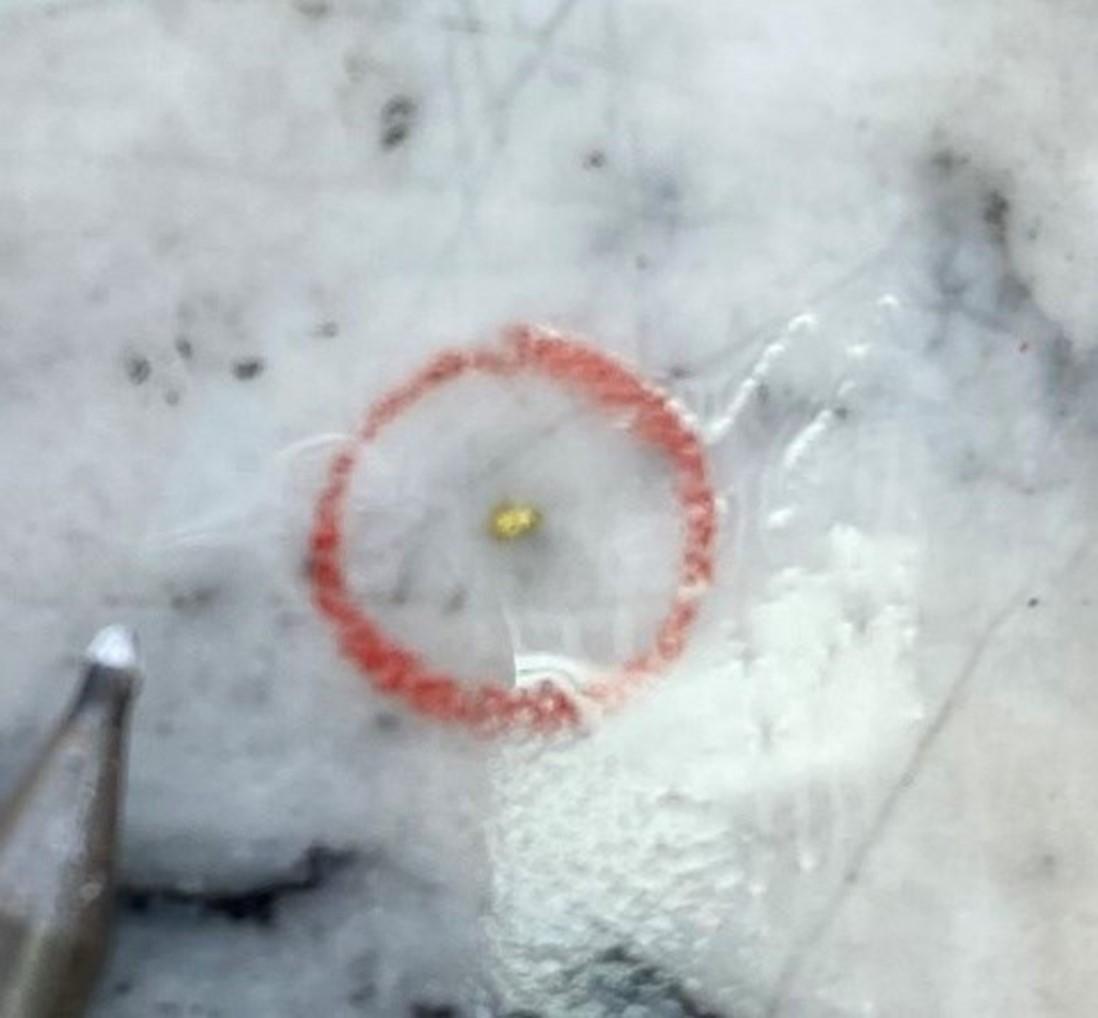
Figure 6. Visible gold encountered in 22VOL-701 hosted in a sulphide-mineralized stylolitic quartz vein at 29.1 m depth with 1 mm x 0.5 mm wide speck of visible gold within a quartz vein.
Drill Hole 22VOL-702
Drill hole 22VOL-702 was designed to test for potential steeply dipping and stacked shear veins. The drill hole tested 150 m below historical drilling where it encountered 21.9 m (drill core length) of altered basalt with intermittent quartz veins and pyrite mineralization (Table 1, Figure 5).
Cusac Vein Target
The Cusac vein system is composed of a series of vein segments that historically produced 90,000 ounces of gold at an average grade of 20.57 g/t Au from 1986 to 1997[4]. In 2022, the Company drilled six holes to: (1) test for extensions of past-producing vein segments, and (2) evaluate the potential for parallel vein sets at the north, west, and south extents of the Cusac system. One drill hole (22BCB-601) was abandoned after encountering a void at 38 m depth.
The completed drill holes confirmed the potential for parallel gold-bearing vein sets to occur near past-producing vein segments at the western extent of the historical Cusac Mine (Figure 7) and compliment results returned from the 2021 drill program (see News Release, May 19, 2022).
Drill holes 22CU-407 and -403
Drill hole 22CU-407 encountered 3.4 m of 2.35 g/t Au from 21.1 m downhole, including 0.8 m of 7.20 g/t Au, and 2.1 m of 1.25 g/t Au from 135.8 m downhole (Table 1, Figure 7). These intercepts suggest that near-surface mineralization may extend west of the known Cusac system mineralization, as well as the potential for mineralization to extend down dip and to the west of past-producing vein segments.
Drill hole 22CU-403 encountered a series of narrow intercepts above 1.0 g/t Au from 55.5 m downhole, implying the potential for parallel gold-bearing vein sets to occur north of the Cusac system. See Table 1, Figure 7 for additional results from the Cusac area.

Figure 7. Plan map of 2022 drill holes reported in this news release, the location of which is shown in Figure 1. The vertical projection of the mineralized intercepts which are reported here are included for reference.
Notes – Historical production figures from Zelligan, Moors, Jolette, April 28, 2022. National Instrument 43-101 Technical Report on the Cassiar Gold Property, prepared for Cassiar Gold Corp, and references therein.
Pooley Pass Target Area
The Pooley Pass area is a brownfields target that comprises a large area between the Bain Mine (Figure 1, 7) and a vein prospect (Pete vein) to the south. The area is host to a major listwanite body which is known to share a spatial association with past producing vein segments elsewhere at Cassiar South. The area has been subject to very limited exploration.
Drill Hole 22POP-800
Drill hole 22POP-800 was designed to test for potential periodicity of parallel vein sets south of the Bain vein system, as well as evaluate the potential for steeply dipping shear veins to occur in the mafic volcanic panel underlying the extensive listwanite body. This drill hole encountered narrow quartz veining and alteration in mafic volcanics, returning 0.5 m of 2.16 g/t Au, confirming the presence of gold-bearing structures in this area, and that a periodicity of the vein systems may continue to the south.
Summary
Together, the results of drilling reported from Cassiar South in 2022 from this and previous news releases (see News Release, April 4, 2023) continue to demonstrate the potential for further expansion of past-producing vein systems and encountering previously untested gold-bearing veins on the property. These results reinforce the potential to identify additional high-grade gold-bearing structures at the project area similar to those mined historically, highlighting the importance of advancing exploration in this area.
Qualified Person
The technical information in this news release has been reviewed and approved by Jill Maxwell, P.Geo., Cassiar Gold Corp.’s Exploration Manager, who is a Qualified Person as defined by National Instrument 43-101.
Quality Assurance and Quality Control
The 2022 Cassiar drilling program comprises HQ drill core oriented using the REFLEX ACTIII system. Drill core samples are selected and logged by geologists prior to being cut in half using a diamond cutting saw at a secure facility located in Jade City, British Columbia. Certified gold reference standards and blanks are routinely inserted into the sample stream as part of the Company’s QA/QC program. All samples are delivered to the ALS Global preparation facility in Whitehorse, Yukon, where they are processed, and then shipped to the ALS Global analytical facility in North Vancouver, British Columbia. Samples are analyzed for gold by 50-gram fire assay with finish by atomic absorption or gravimetric methods. Screen metallic analysis is performed on selected samples. ALS Global quality systems and technical aspects conform to requirements of ISO/IEC Standard 17025 guidelines.
About Cassiar Gold Corp.
Cassiar Gold Corp. is a Canadian gold exploration company holding a 100% interest in its flagship Cassiar Gold Property located in British Columbia, Canada. The Cassiar Gold property spans 590 km2 and consists of two main project areas: Cassiar North, which hosts a NI 43-101-compliant inferred resource estimate of 1.4Moz at 1.14 g/t Au (cutoff grade of 0.5 g/t Au) known as the as the Taurus Deposit (see National Instrument 43-101 Technical report on the Cassiar Gold property, April 28, 2022, by S. Zelligan, J. Moors, C. Jolette, posted to SEDAR); and Cassiar South which hosts numerous gold showings, historical workings, and exploration prospects. Historical underground mines in the Cassiar South area have yielded over 315,000 oz of Au at average grades of between 10 and 20 g/t Au (2022, Zelligan, Jolette, Moors1), underscoring the high potential for further discovery and expansion of high-grade orogenic gold veins.
The Company also holds a 100% interest in the Sheep Creek gold camp located near Salmo, BC. The Sheep Creek gold district ranks as the third largest past-producing orogenic gold district in BC with historical gold production of 742,000 ounces gold at an average grade of 14.7 g/t gold from 1900 to 1951. Minimal exploration work has been conducted since the 1950s.
Cassiar Gold Corp. acknowledges, respects, and supports the rights of Traditional First Nations in the lands and communities where we operate.
MORE or "UNCATEGORIZED"
Kuya Silver Confirms High-Grade Silver-Gold Vein Mineralization at Umm-Hadid with Initial Drill Results up to 1483.9 g/t AgEq over 2 Metres
Kuya Silver Corporation (CSE: KUYA) (OTCQB: KUYAF) (FSE: 6MR1) is... READ MORE
First Phosphate Closes Final Tranche of Oversubscribed Private Placement
First Phosphate Corp. (CSE: PHOS) (OTCQX: FRSPF) (FSE: KD0) is... READ MORE
GFG Receives Final Payment from the Sale of its Rattlesnake Hills Gold Project
GFG Resources Inc. (TSX-V: GFG) (OTCQB: GFGSF) announces that i... READ MORE
Goliath Receives $1,730,882 Through Warrant Exercises, Inclusive Of Crescat Capital A Longtime Strategic And Cornerstone Shareholder
Goliath Resources Limited (TSX-V: GOT) (OTCQB: GOTRF) (FSE: B4IF)... READ MORE
Robex Pours First Gold at Kiniéro on Schedule and Budget
Highlights: Gold bar weighing 2.64 kilograms (85 oz) poured in th... READ MORE












